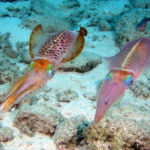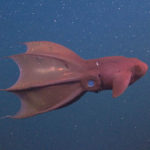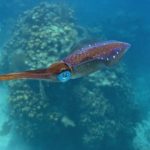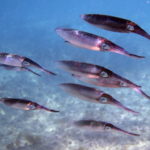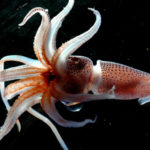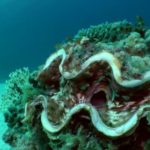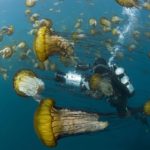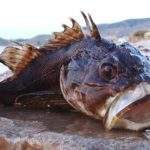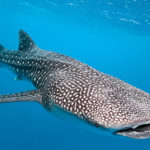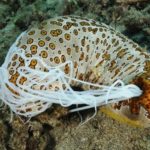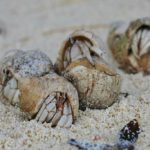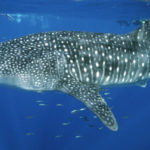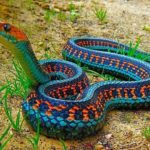30 interesting and fun facts about squid
 A huge number of different types of squid live in the world, and many of them are unlike each other. Large and small, dangerous and harmless, all of them, however, have a number of similarities, according to zoologists. And it is possible that in the depths of the seas and oceans live their new species, still not studied by mankind.
A huge number of different types of squid live in the world, and many of them are unlike each other. Large and small, dangerous and harmless, all of them, however, have a number of similarities, according to zoologists. And it is possible that in the depths of the seas and oceans live their new species, still not studied by mankind.
Some of their species spend their whole lives in complete darkness, at a depth of 1000-1500 meters.
The deep-sea giant squid is considered the largest of all. Its length can reach 8 meters, of which up to 2.5 meters falls on the body itself, and the rest on tentacles.
Squids are found both in the tropics and in cold Arctic waters.
Squid habitat is the salt waters of the oceans, these mollusks are not adapted for life in fresh watering.
Squids are close relatives of cuttlefish and octopuses.
In nature, there are more than 300 species that differ from each other in size, color and body structure.
Of all the underwater inhabitants, squids are considered the least studied. Zoologists believe that in the seas and oceans there are still up to 200 of their species, still not discovered, because they live at considerable depths.
Squids that live in the waters of the cold Arctic seas have an almost colorless, and sometimes even translucent, body.
The closer to the surface, the smaller their body size. Their largest species live only at great depths.
All squids have 10 tentacles, of which 2 are hunters (they catch prey), and the rest serve as auxiliary “hands”.
In addition to the well-known flying fish, there are flying squids that live in the Pacific Ocean, but their flight methods are completely different. Fish to jump out of the water use quick and strong tail strokes, and then soar with the help of wide fins, while squids both in the water and above its surface move due to jet propulsion, that is, in the direction opposite to the jet of water thrown out. However, squids are far inferior in flight range: their maximum distance according to observations does not exceed 30 meters, and the record for flying fish is 400 meters.
The squid’s blood is not red, but blue, since the oxygen in their blood is transported by copper, not iron, as in mammals.
Squid Octopoteuthis deletron, living at a depth of up to 800 meters, is characterized by a very short period of puberty. Therefore, the males have developed a breeding strategy in which they do not understand who is in front of them – a female or another male. Meeting in the dark squid their species of any gender, they attack it and smear it with spermatophores, that is, capsules with sperm.
These animals have not one heart, but three, and each of them is connected to one of the tentacles. Two hearts pump blood in the third, and it already distributes blood throughout the body.
Some types of squid have eyes that differ in size: one is larger, the other is smaller. Each of them captures a different light intensity.
The eyes of a giant squid, the largest of all, are larger than a soccer ball. The largest specimen had an eye with a diameter of 27 cm, and 9 of them accounted for the pupil. These are the largest eyes among all living things on Earth.
These animals have good eyesight, despite the fact that many of them live where the sun does not shine.
The hardest part of their body is the cartilaginous part of the head in which the brain is located.
About 1% of the diet of various marine animals are squids.
The nerve fibers in these animals are much thicker than in humans, which helps to instantly respond to changes in the situation.
The squid has a fairly high level of intelligence and has brain cells, and its manner of behavior speaks of a balanced tactics of behavior in extreme situations. Moreover, the weight of his brain is small in relation to the weight of his body.
The diameter of the suction cups of a giant squid can reach 5-6 centimeters.
There are species of squid that also have sharp claws at the ends of the tentacles.
And with a lack of food, they easily become cannibals, and willingly eat their smaller relatives.
Small squid species have negative buoyancy and are forced to constantly use the energy-consuming jet release mechanism to stay afloat. Giant squid species, on the contrary, have neutral buoyancy due to the presence of ammonium chloride in the body. This allows giant deep-sea mollusks to “soar” in water.
In water, these creatures move only tentacles forward. They do not know how to move forward.
Despite the absence of teeth, squids have a beak that easily pierces the ridge of fish and even the shell of crabs.
Some of their deep-sea species can glow in the dark, emitting a blue or purple color.
Glass squid got its name because its body is completely transparent. Only his eyes and digestive organs are opaque.
Some types of squid migrate annually, overcoming a distance of thousands of kilometers.
